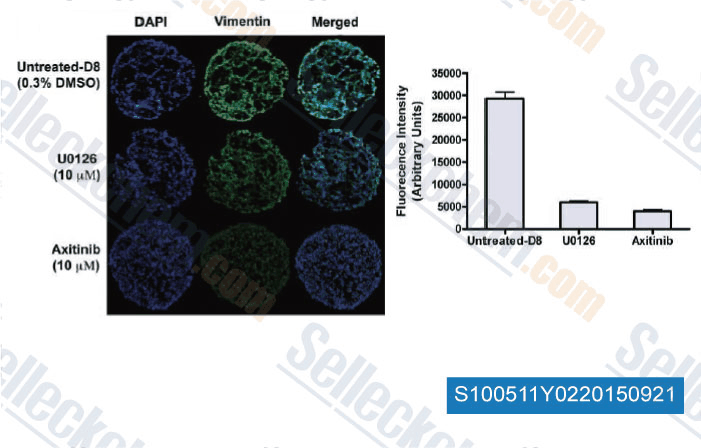|
Toll Free: (877) 796-6397 -- USA and Canada only -- |
Fax: +1-832-582-8590 Orders: +1-832-582-8158 |
Tech Support: +1-832-582-8158 Ext:3 Please provide your Order Number in the email. |
Technical Data
| Formula | C22H18N4OS |
||||||||||
| Molecular Weight | 386.47 | CAS No. | 319460-85-0 | ||||||||
| Solubility (25°C)* | In vitro | DMSO | 26 mg/mL (67.27 mM) | ||||||||
| Water | Insoluble | ||||||||||
| Ethanol | Insoluble | ||||||||||
| In vivo (Add solvents to the product individually and in order) |
|
||||||||||
|
* <1 mg/ml means slightly soluble or insoluble. * Please note that Selleck tests the solubility of all compounds in-house, and the actual solubility may differ slightly from published values. This is normal and is due to slight batch-to-batch variations. * Room temperature shipping (Stability testing shows this product can be shipped without any cooling measures.) |
|||||||||||
Preparing Stock Solutions
Biological Activity
| Description | Axitinib is a multi-target inhibitor of VEGFR1, VEGFR2, VEGFR3, PDGFRβ and c-Kit with IC50 of 0.1 nM, 0.2 nM, 0.1-0.3 nM, 1.6 nM and 1.7 nM in Porcine aorta endothelial cells, respectively. | |||||||||||
|---|---|---|---|---|---|---|---|---|---|---|---|---|
| Targets |
|
|||||||||||
| In vitro | Axitinib could block the cellular autophosphorylation of VEGFR and VEGF-mediated endothelial cell viability, tube formation, and downstream signaling. Axitinib inhibits the proliferation of variable cell lines with IC50 of >10,000 nM (IGR-N91), 849 nM (IGR-NB8), 274 nM (SH-SY5Y) and 573 nM (non-VEGF stimulated HUVEC). [2] | |||||||||||
| In vivo | Axitinib exhibits primary inhibition to orthotopically transplanted models such as M24met (melanoma), HCT-116 (colorectal cancer), and SN12C (renal cell carcinoma). [1] Axitinib delays the tumor growth with 11.4 days compared to the controls (p.o. 30 mg/kg) and decreases the Mean Vessels Density (MVD) to 21, compared to 49 in controls, in IGR-N91 flank xenografts. [2] Axitinib significantly inhibits growth and disrupts tumor microvasculature in BT474 breast cancer model at 10-100 mg/kg. [3] Axitinib has shown single-agent activity in variable tumors, including renal cell carcinoma, thyroid cancer, non-small cell lung cancer, and melanoma. | |||||||||||
| Features | Superior as second-line therapy relative to sorafenib (current standard-of-care). |
Protocol (from reference)
| Kinase Assay: |
|
|---|---|
| Cell Assay: |
|
| Animal Study: |
|
References
Customer Product Validation

-
Data from [J Biomol Screen, 2011, 16, 141-154]

-
, , Oncogene, 2017, 36(36):5098-5109

-
, , Dr. Cheri Pasch of UW Madison

-
Data from [Data independently produced by , , J Biomol Screen, 2011,16: 141-154]
Selleck's Axitinib has been cited by 192 publications
| Piezo1 regulates meningeal lymphatic vessel drainage and alleviates excessive CSF accumulation [ Nat Neurosci, 2024, 10.1038/s41593-024-01604-8] | PubMed: 38528202 |
| Targeting PDGF signaling of cancer-associated fibroblasts blocks feedback activation of HIF-1α and tumor progression of clear cell ovarian cancer [ Cell Rep Med, 2024, S2666-3791(24)00201-5] | PubMed: 38670097 |
| FLT1 activation in cancer cells promotes PARP-inhibitor resistance in breast cancer [ EMBO Mol Med, 2024, 10.1038/s44321-024-00094-2] | PubMed: 38956205 |
| The molecular basis of Abelson kinase regulation by its αI-helix [ Elife, 2024, 12RP92324] | PubMed: 38588001 |
| ROCK and the actomyosin network control biomineral growth and morphology during sea urchin skeletogenesis [ Elife, 2024, 12RP89080] | PubMed: 38573316 |
| Transcription of microRNAs is regulated by developmental signaling pathways and transcription factors [ Front Cell Dev Biol, 2024, 12:1356589] | PubMed: 38721525 |
| New Anti-Angiogenic Therapy for Glioblastoma With the Anti-Depressant Sertraline [ Cancer Med, 2024, 13(20):e70288] | PubMed: 39440923 |
| Cardiomyocyte crosstalk with endothelium modulates cardiac structure, function, and ischemia-reperfusion injury susceptibility through erythropoietin [ Front Physiol, 2024, 15:1397049] | PubMed: 39011088 |
| Xuebijing improves intestinal microcirculation dysfunction in septic rats by regulating the VEGF-A/PI3K/Akt signaling pathway [ World J Emerg Med, 2024, 15(3):206-213] | PubMed: 38855370 |
| Expression and Transcriptional Targets of TGFβ-RII in Paracentrotus lividus Larval Skeletogenesis [ Genesis, 2024, 62(4):e23614] | PubMed: 39139086 |
RETURN POLICY
Selleck Chemical’s Unconditional Return Policy ensures a smooth online shopping experience for our customers. If you are in any way unsatisfied with your purchase, you may return any item(s) within 7 days of receiving it. In the event of product quality issues, either protocol related or product related problems, you may return any item(s) within 365 days from the original purchase date. Please follow the instructions below when returning products.
SHIPPING AND STORAGE
Selleck products are transported at room temperature. If you receive the product at room temperature, please rest assured, the Selleck Quality Inspection Department has conducted experiments to verify that the normal temperature placement of one month will not affect the biological activity of powder products. After collecting, please store the product according to the requirements described in the datasheet. Most Selleck products are stable under the recommended conditions.
NOT FOR HUMAN, VETERINARY DIAGNOSTIC OR THERAPEUTIC USE.
